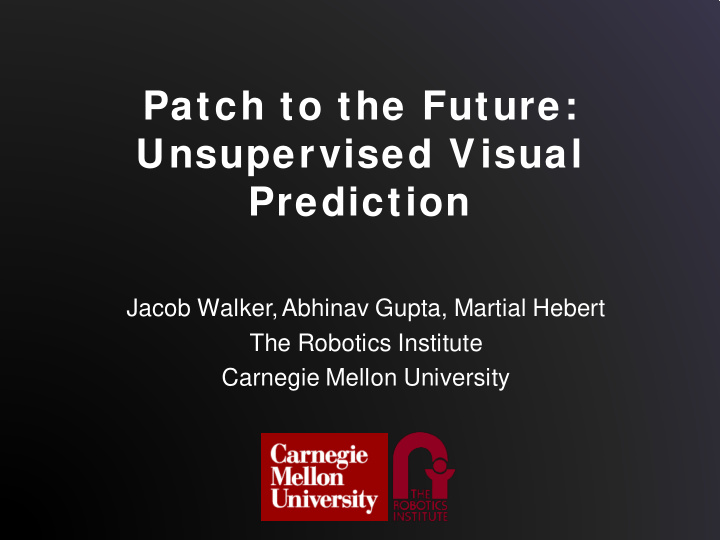



Patch to the Future: Unsupervised Visual Prediction Jacob Walker, Abhinav Gupta, Martial Hebert The Robotics Institute Carnegie Mellon University
Visual Prediction
Goal Both the what and the how
Goal Both the what and the how
Goal Both the what and the how
Goal Both the what and the how
Goal Both the what and the how
Goal Both the what and the how
Background Data-Driven Yuen et al. 2010
Background Data-Driven Yuen et al. 2010
Background Data-Driven Yuen et al. 2010
Background Agent-Centric Kitani et al. 2012, Koppula et al. 2013, etc.
Background Agent-Centric Kitani et al. 2012, Koppula et al. 2013, etc.
Our Approach Data-Driven
Our Approach Data-Driven + Agent-Centric
Our Approach Unsupervised
Limitations Domain-Dependent Train Test
Limitations Goal-Driven
Limitations No Inter-Element Prediction
Overview
Representation Singh et al. 2012
Action Space
Scene Interaction
Scene Interaction
Scene Interaction High Low
Expected Reward P(Transition) Reward(X,Y,C) E(Reward) = P(T) * R
Planning
Planning
Planning
Planning
Planning
Planning
Planning
Planning
Planning
Planning
Planning
Planning
Planning
Planning
Training Transitions Scene Interaction
Training Transitions Scene Interaction
Training Transitions
Training Patch Transitions
Training Transitions Scene Interaction
Training Scene Interaction
Training Scene Interaction
Training Scene Interaction
Training Scene Interaction
Training Scene Interaction
Datasets • 183 Videos • 139 Training • 44 Testing • ~300 Minutes
Qualitative Results
Qualitative Results
Quantitative Results
Quantitative Results Data-Driven Active Entity Error (Top 6) NN + Sift-Flow Ours Mean 22.34 14.38 Median 16.68 10.91
Quantitative Results Human-Chosen Active Entity Error (Top 1) NN+Sift-Flow Kitani et al. Ours Mean 27.55 37.94 21.55 Median 23.77 30.23 14.98
VIRAT Second Dataset
Conclusion • Unsupervised method for prediction • No explicit modeling of semantics • Models appearance changes • Code will be available!
Thank You!
Recommend
More recommend